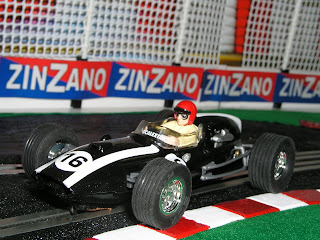
The Cooper Car Company was founded by Charles Cooper and his son John Cooper in 1947. Together, they began by building racing cars in Charles' small garage in Surbiton, Surrey . In the late 1950s and early 1960s, they reached the highest levels in auto racing as their rear-engined, single-seat cars altered the face of Formula 1 and the Indianapolis 500. Thanks in part to Cooper's legacy, U.K remains the home of a thriving racing industry, and the Cooper name lives on in the Mini Cooper production cars now owned and marketed by BMW.
The first cars built by the Coopers were single-seater, 500cc Formula racing cars driven by John Cooper and Eric Brandon and powered by a JAP motorcycle engine. Since materials were in short supply, the cars were constructed by joining two old Fiat Topolino front-ends together. According to John Cooper, the stroke of genius that would make the Coopers an automotive legend -- the location of the engine behind the driver -- was merely a practical matter at the time. Because the car was powered by a motorcycle engine, they believed it was more convenient to have the engine in the back, driving a chain.
Called the Cooper 500, this car's success on the track instantly created a demand from other drivers (including, Bernie Ecclestone, the owner of Formula 1). Built with parts salvaged from military barracks and aircraft factories, and fitted with a series of different motorcycle engines, Cooper 500s won 64 out of 78 major races between 1951 and 1954. It was with a modified Cooper 500 chassis that Cooper had its first taste of top-tier racing when Harry Schell retired on the first lap of the Monaco Grand Prix in 1950.
The front-engined, Formula 2 Cooper was introduced in 1952. This design with some changes were driven by a number of legendary drivers - among them Fangio and Hawthorn and furthered the company's growing reputation by appearing in Grand Prix races, which at the time were run to F2 regulations. It wasn't until the company began building rear-engined sports cars in 1955 that they really became aware of the benefits of having the engine behind the driver. Based on the 500cc cars and powered by a modified Coventry Climax fire-pump engine, these cars were called "Bobtails." With the center of gravity closer to the middle of the car, they found that it was less liable to spin out and much more effective at putting the power down to the road, so they decided to build a single-seater version and began entering it in Formula 2 races.
In 1959 Brabham and the factory Cooper team became the first to win the Formula One World Championship in a rear-engined car. Both team and driver in 1960, and every World Champion since has been sitting in front of his engine.
Brabham took one of the Championship-winning Cooper T53 "Lowline" to Indianapolois for a test in 1960, then entered the famous 500-mile race in a larger, longer and offset car based on the 1960 F1 design. Arriving at the Speedway May 5, 1961, the "funny" little car from Europe was mocked by the other teams, but it ran as high as third and finished ninth. It took a few years, but the Indianapolis establishment gradually realized the writing was on the wall and the days of their front-engined roadsters were numbered.
Once every Formula car manufacturer began building rear-engined racers, the practicality and intelligent construction of Cooper's single-seaters was overtaken by more sophisticated technology from other teams (Lola, BRM, Ferrari and Lotus). The Cooper team's decline was accelerated when John Cooper was seriously injured in a road accident in 1963 driving a twin engined Mini and Charles Cooper died in 1964. Their final Formula One victory was achieved by Mexican driver Rodriguez at the 1967 South African Grand Prix. In all, Coopers participated in 129 Formula One World Championship events in nine years, winning 16 races.
After the death of his father, John Cooper sold the Cooper Formula One team to the Chipstead Motor Group in April, 1965. John Cooper died on 24 December 2000
In 1959 Brabham and the factory Cooper team became the first to win the Formula One World Championship in a rear-engined car. Both team and driver in 1960, and every World Champion since has been sitting in front of his engine.
Brabham took one of the Championship-winning Cooper T53 "Lowline" to Indianapolois for a test in 1960, then entered the famous 500-mile race in a larger, longer and offset car based on the 1960 F1 design. Arriving at the Speedway May 5, 1961, the "funny" little car from Europe was mocked by the other teams, but it ran as high as third and finished ninth. It took a few years, but the Indianapolis establishment gradually realized the writing was on the wall and the days of their front-engined roadsters were numbered.
Once every Formula car manufacturer began building rear-engined racers, the practicality and intelligent construction of Cooper's single-seaters was overtaken by more sophisticated technology from other teams (Lola, BRM, Ferrari and Lotus). The Cooper team's decline was accelerated when John Cooper was seriously injured in a road accident in 1963 driving a twin engined Mini and Charles Cooper died in 1964. Their final Formula One victory was achieved by Mexican driver Rodriguez at the 1967 South African Grand Prix. In all, Coopers participated in 129 Formula One World Championship events in nine years, winning 16 races.
After the death of his father, John Cooper sold the Cooper Formula One team to the Chipstead Motor Group in April, 1965. John Cooper died on 24 December 2000
Comments